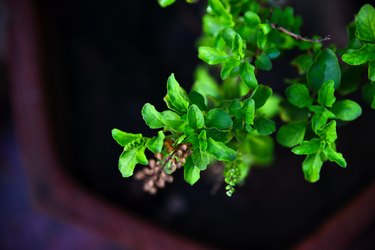
Holy basil, known as tulsi in India (Ocimum tenuiflorum, USDA hardiness zones 10-12), has a warm pungent aroma with a mildly spicy scent. This sweet, unique fragrant herb does not keep long after it is picked so you need to dry or freeze your basil harvest so it can be used in the middle of winter. Holy basil should be harvested before the flowers appear and do not let it go to seed as both can affect the flavor. If you want the color of the flowers in your dried holy basil mix, then wait for the flower heads to open up.
Notable Characteristics of Holy Basil
Video of the Day
Holy basil performs as an annual, short-lived perennial or sub-shrub and belongs in the mint family Lamiaceae and is native to tropical and subtropical areas of Southern Asia. It's closely related to culinary sweet basil (Ocimum basilicum) but instead of the leaves being solid green, holy basil's foliage has a purple tint. In addition, sweet basil's flowers are larger and it has a longer lifespan than holy basil does, according to NC State Extension.
Video of the Day
Holy basil has an upright, multi-branched habit and quickly reaches a mature height of around 3 feet. It performs best when planted in full sun and tolerates a wide variety of soils provided they are well-drained and don't have a tendency to remain wet. The highly fragrant oblong leaves are hairy and around 1 to 3 inches long and an inch wide. Tubular flowers range in colors of pink, white or lavender. Holy basil also grows well planted in containers provided they have bottom drainage.
When it comes to when to pick basil, for the best flavor you should harvest it before the holy basic plant blooms. Although the blooms are edible, the basil can take on a bitter taste if allowed to flower. You can also extend the harvest by snipping off the flowers as they start to form and before the plant goes to seed, according to Iowa State University.
Harvesting Holy Basil Plants
Step 1: Prepare to Harvest
Harvest the holy basil early in the morning before the day heats up, as the basil will have the best flavor. Use clean pruning tools or scissors to cut the basil so you don't transfer any disease to the plant. Wipe the blades off with something like alcohol.
Step 2: Harvesting the Holy Basil Plant
Using clean tools, snip off the desired portion of the leaves and stems from the holy basil plant. Don't snip off more than half the plant so it can regrow additional leaves you can continue to harvest in several more weeks. Pinch off any discolored or damaged leaves.
Step 3: Store the Basil in Water
Store any fresh holy basil you don't plan on using immediately in a glass of water. The freshly cut stems of the basil will store well placed in the container of water and stored on a kitchen counter for a couple of days.
Step 4: Dry the Holy Basil
Dry the basil by tying several bunches together with some twine and hang them upside down in a cool, dark and well-ventilated area. Once dry, you can smash the leaves up and store them in a plastic container. Dried holy basil will keep for around a year.
Step 5: Freeze the Holy Basil
Freeze the holy basil by first removing the leaves from the stems and placing them in a food processor and chopping them up. Once chopped, add a little water or oil to the mixture, pour into ice cube trays and freeze for future use. Frozen holy basil will keep for around a year.
Things You'll Need
Pruning tools
Scissors
Alcohol
Glass
Twine
Plastic container
Food processor
Oil
Ice cube tray